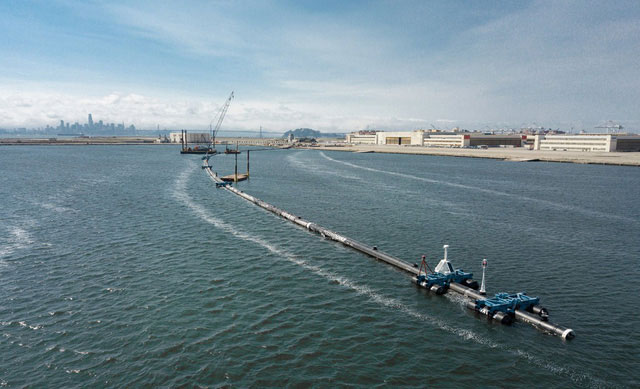Start testing giant plastic garbage collection traps in the Pacific
A floating trap was laid on San Francisco Bay on September 8, 2018 to collect garbage on the Pacific Ocean. This is the beginning of an ambitious plan to clean up the largest ocean on Earth.
Initiated by the Dutch inventor, the 24-year-old boy, Boyan Slat , is a non-profit project that aims to collect about 68 tons of plastic waste at sea in the first year. The floating trap operated by an automatic, non-driver mechanism, with a total cost of about 20 million USD, will continue to be expanded in the next 5 years in the hope of cleaning up the ½ giant waste island in Thailand. Binh Duong.
This trash island is located between California and Hawaii, estimated to include 1.8 trillion floating pieces of waste, of which plastic waste is estimated at 87,000 tons.
In the next few days, this floating trap will be towed to a test site for two weeks. If everything goes as well as planned, then the trap will be transferred to the garbage island, about 2,250 km away from the shore in the middle of October 2018.

This floating trap will be towed to a test site for two weeks.
This garbage trap system is expected to operate as follows: after the trap is separated from the tugboat, the water flow will pull it into a U shape. When it driftes thanks to the wind blowing in combination with the waves, it will collect plastic waste. again. Plastic waste will then be moved to shore, sorted and recycled.
The trap has a flap that is nearly 3 meters long from the water to the sea so that small pieces of water can be kept under water. According to inventors, marine organisms can still escape from traps when swimming deeper than 3 meters.
Even so, the ocean still contains many unpredictable things and simulation models cannot guarantee actual field operations. According to George Leonard, a scientist at the Oceanic Conservancy, USA, according to the experience from the fisheries industry, when dropping any structure into open waters, it becomes a receiver. smoking fish. Small fish caught in this new device will again be the prey to attract larger fish, creating a complete ecosystem of ecosystems.
It is not yet clear to what extent this trap will work well off the open sea, with strong winds, corrosive salt water and many other environmental challenges. And one question is whether it is possible to clean up half of the garbage in only five years.
According to Leonard, the big challenge here is not a long-term goal, but a short-term goal, whether this trap will get plastic waste. And the Slat inventor has the same idea. Talking about the ability to collect and retain rubbish, he said: 'The thing that I am most worried about is the time, this is the first factor we can not accurately test. But I am extremely confident at the opportunity to succeed this time. '
Since the start of the 'Ocean Cleaning' initiative in 2013, the initiative has received nearly 35 million dollars contributed by philanthropists. Most of this money is invested in the above garbage trap and the accompanying research. According to estimates, each of the program's next similar traps will cost about 5.8 million USD.
In terms of cost effectiveness, is this the most economical way to handle this problem? Inventor Slat thinks this is not a perfect solution to the problem of waste pollution. However, in addition to preventing further dumping of plastic waste into the sea, there must be some way to handle the existing garbage on the sea. We must clean the sea at some point and it should be as soon as possible.
- Garbage in the Pacific increased 100 times
- The giant Pacific Island trash island will be cleared with this wonderful system
- Plastic landfill on the sea is as large as 3 European countries
- Huge ocean garbage collection system
- Prohibit selling plastic water bottles to reduce garbage
- 99% of plastic garbage on the sea has disappeared?
- 8 ways to reuse plastic bags are good, you should apply as soon as possible
- Plastic waste alarm in the Pacific
- Thinking that penguins are living on trash island, the truth is much more terrible
- Ocean garbage attracts adventurers
- 99.99% of plastic garbage on the sea turned out to be deep in the ocean without us knowing
- Another heartbreaking image of pollution of plastic garbage: Sharks die while sucking on water bottles
 Is the magnetic North Pole shift dangerous to humanity?
Is the magnetic North Pole shift dangerous to humanity? Washington legalizes the recycling of human bodies into fertilizer
Washington legalizes the recycling of human bodies into fertilizer Lightning stone - the mysterious guest
Lightning stone - the mysterious guest Stunned by the mysterious sunset, strange appearance
Stunned by the mysterious sunset, strange appearance